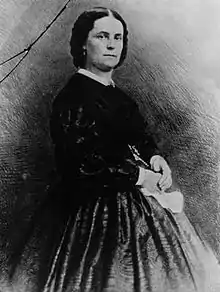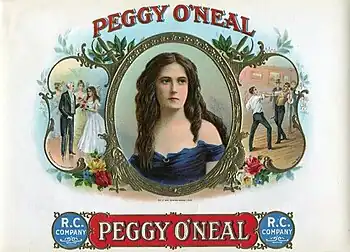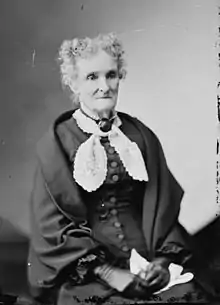Peggy Eaton
Margaret Eaton (née O'Neill, formerly Timberlake, later Buchignani; December 3, 1799 – November 8, 1879), was the wife of John Henry Eaton, a United States senator from Tennessee and United States Secretary of War, and a confidant of Andrew Jackson. Their marriage was the cause of a national controversy known as the Petticoat affair. While better known in history as Peggy, Margaret stated in her autobiography, "I never was called Peggy in all my life...I was ordinarily called by my proper name of Margaret."[1]
Peggy Eaton | |
|---|---|
 | |
| Born | December 3, 1799 Washington, D.C., U.S. |
| Died | November 8, 1879 (aged 79) Washington, D.C., U.S. |
| Resting place | Oak Hill Cemetery Washington, D.C., U.S. |
| Nationality | American |
| Spouses | Antonio Gabriele Buchignani
(m. 1859; div. 1869) |
| Children | 3 |

Early life
Margaret O'Neill was the daughter of Rhoda Howell and William O'Neill,[2] the owner of Franklin House, a popular Washington, D.C., hotel. She had five siblings: William, Robert, John, Mary, and Georgianna.[1]
As a girl, she was noted for her beauty, wit and vivacity. Well-educated for her time and gender, she studied French and was known for her ability to play the piano.[3] William T. Barry, who later served as Postmaster General, wrote "of a charming little girl...who very frequently plays the piano, and entertains us with agreeable songs." As a young girl, her reputation was already under scrutiny because she worked in a bar frequented by men and casually bantered with the boardinghouse clientele. An elderly Margaret reminisced that, "While I was still in pantalets and rolling hoops with other girls I had the attention of men, young and old, enough to turn a girl's head."[4]
First marriage
About 1816, at age 17, Margaret O'Neill married John B. Timberlake, a 39-year-old purser in the Navy. Her parents gave them a house across from the hotel, and they met many politicians who stayed there. In 1818 they met and befriended John Henry Eaton, a 28-year-old widower and newly elected senator from Tennessee. Margaret and John Timberlake had three children: William (b. 1817; d. 1818); Mary Virginia (b. 1819); and Margaret Rose (1825–1855).[5][6]
Second marriage and scandal
John Timberlake died in 1828 while at sea in the Mediterranean, in service on a four-year voyage. Though the conventions of society required an extended mourning period, the widow Margaret Timberlake married Senator Eaton on January 1, 1829, just nine months after Timberlake's death. As a result, rumors circulated that Timberlake had committed suicide because of despair at an alleged affair between his wife and Eaton. An autopsy concluded that Timberlake died of pneumonia brought on by pulmonary disease.
After John Eaton was appointed as Secretary of War, rumors continued and Margaret Eaton was snubbed by other cabinet wives. Her honor was defended by President Andrew Jackson, and she became the subject of the Petticoat affair, in which the wives of cabinet members and other prominent Washingtonians refused to pay social calls on the Eatons and refused them invitations to parties and other events.
Jackson tried unsuccessfully to coerce the cabinet wives into ending their snubbing of the Eatons. Vice President John C. Calhoun, whose wife, Floride Calhoun, was seen as the anti-Eaton ringleader, supported his wife. This caused Jackson to transfer his favor to widower Martin Van Buren, the Secretary of State, who had taken the Eatons' side and shown positive social attention to Margaret. Van Buren helped end the Petticoat Affair by resigning, which gave Jackson the ability to remove his anti-Eaton cabinet members. Calhoun was not renominated for vice president and resigned shortly before the end of his term to accept election to the U.S. Senate. Van Buren became vice president in 1833, and was well-placed to become Jackson's successor in 1837.
Societal implications
Historian John F. Marszalek explained his view of the real reasons Washington society found Margaret unacceptable:
She did not know her place; she forthrightly spoke up about anything that came to her mind, even topics of which women were supposed to be ignorant. She thrust herself into the world in a manner inappropriate for a woman...Accept her, and society was in danger of disruption. Accept this uncouth, impure, forward, worldly woman, and the wall of virtue and morality would be breached and society would have no further defenses against the forces of frightening change. Margaret Eaton was not that important in herself; it was what she represented that constituted the threat. Proper women had no choice; they had to prevent her acceptance into society as part of their defense of that society's morality.
Author Jon Meacham points out that Margaret Eaton's life was unusual for its time. She was, according to Meacham "by her own account...an outgoing flirt" – her tongue was "ungoverned, and ungovernable." He also points out that she craved attention: "At various points in her life she was courted by an adjutant general, a major and a captain – which delighted her."
In a memoir published long after her death, Margaret admitted to the accuracy of some of the characterizations of her: "The fact is, I never had a lover who was not a gentleman and was not in a good position in society." "I must have said a great many foolish things" wrote Margaret, "I am sure I did very few wise ones. I was foolish, hasty, but not vicious." Refusing to defend herself directly, Margaret Eaton expressed her opinion of her critics this way: "I was quite as independent as they, and had more powerful friends...None of them had beauty, accomplishments or graces in society of any kind, and for these reasons...they were jealous of me."
Meacham observes that, "it's impossible...to assess the truth of the charges" lodged by her enemies, but "she offers this "interesting defense":
"Just let a little commonsense be exercised. While I do not pretend to be a saint, and do not think I was ever very much stocked with sense, and lay no claim to be a model woman in any way, I put it to the candor of the world whether the slanders which have been uttered against me are to be believed."
Third marriage and later life

Three years after the death of her second husband, Margaret Eaton married Antonio Gabriele Buchignani, an Italian music teacher and dancing master, on June 7, 1859.[7] She was 59 and he was in his mid-20s. The marriage reignited much of the social stigma Margaret had carried earlier in life.
In 1866, their seventh year of marriage, Buchignani ran off to Europe with the bulk of his wife's fortune as well as her 17-year-old granddaughter Emily E. Randolph. He married Randolph after he and Margaret divorced in 1869.[8][9][10][11]
Although Margaret Eaton obtained a divorce from Buchignani, she was not able to recover her financial standing. She died in poverty in Washington, D.C., on November 8, 1879, and was buried at Oak Hill Cemetery.[12][13]
References
- Eaton, Margaret (1932). The Autobiography of Peggy Eaton. New York: Scribner's Sons. pp. 6–7, 32.
- Coit 1975, p. 546
- "Andrew Jackson: The Petticoat Affair, Scandal in Jackson's White House". History Net. Retrieved August 4, 2009.
- Wood, Kristen E. (March 1, 1997). "One Woman so Dangerous to Public Morals". Journal of the Early Republic. 17 (2): 237–75. doi:10.2307/3124447. JSTOR 3124447.
- The Timberlakes' daughter Virginia, after a broken engagement to Philip Barton Key II, son of Francis Scott Key, married a French diplomat, Antoine Sampayo. One of the Sampayos' granddaughters was Olga de Meyer, the wife of photographer Adolph de Meyer.
- Marszalek, John F. (1997). The Petticoat Affair: Manners, Mutiny, and Sex in Andrew Jackson's White House. New York: Free Press. pp. 38, 227. ISBN 0-684-82801-4. OCLC 36767691.
- Eli Field Cooley; William Scudder Cooley (1889). Genealogy of Early Settlers of Trenton and Ewing. W. S. Sharp. p. 157.
- The Charleston daily News (PDF), September 14, 1868 In September 1868 Peggy appeared against Buchignani in the Jefferson Market Police Court.
- Buchignani was close to the family of Abraham Lincoln, who appointed him as secretary to the U.S. legation at Naples and then assistant librarian of Congress. In New York City, during his marriage to Eaton, he operated the Opera Café and Hotel. According to an 1868 article about the case in The New York Times, Margaret Eaton agreed to divorce her husband if he would marry her granddaughter and restore her good name.
- Evening Star (Washington DC), December 24, 1891 reports Gabriel Antonio Buchignani died in New York City on December 22, 1891 at the age of 57 and that his wife Emily had "died some years ago"
- A son Emile Buchignani was born 1874 in Tennessee and married in New York City in 1908
- Notable American Women. 1971. ISBN 9780674627345 – via Google Books.
- "Oak Hill Cemetery, Georgetown, D.C." (PDF). oakhillcemeterydc.org. Archived (PDF) from the original on 2022-03-02. Retrieved 2022-08-15.
Further reading
- "Margaret 'Peggy' Eaton". The Tennessee Encyclopedia of History and Culture. Nashville, Tennessee: Tennessee Historical Society. 1998.
- Allgor, Catherine (2000). Parlor Politics: In Which the Ladies of Washington Help Build a City and a Government. Charlottesville: University Press of Virginia.
- Coit, Margaret L. (1975). "Eaton, Margaret O'Neale". Notable American Women (4th ed.). The Belknap Press of Harvard University Press. 1. (reprinted from 1911).
- Latner, Richard B. (1977). "The Eaton Affair Reconsidered". Tennessee Historical Quarterly. 36 (3): 330–51. JSTOR 42623838.
- Marszalek, John F. (2000). The Petticoat Affair: Manners, Mutiny and Sex in Andrew Jackson's White House. Louisiana State University Press.
- Meacham, Jon (2008). American Lion.
- Wood, Kirsten E. (1997). "'One Woman so Dangerous to Public Morals': Gender and Power in the Eaton Affair". Journal of the Early Republic. 17 (2): 237–75. doi:10.2307/3124447. JSTOR 3124447.
External links
- "Little Friend Peg", Founders of America
- . New International Encyclopedia. 1905.
- . Appletons' Cyclopædia of American Biography. 1900.
- Peggy Eaton at Find a Grave